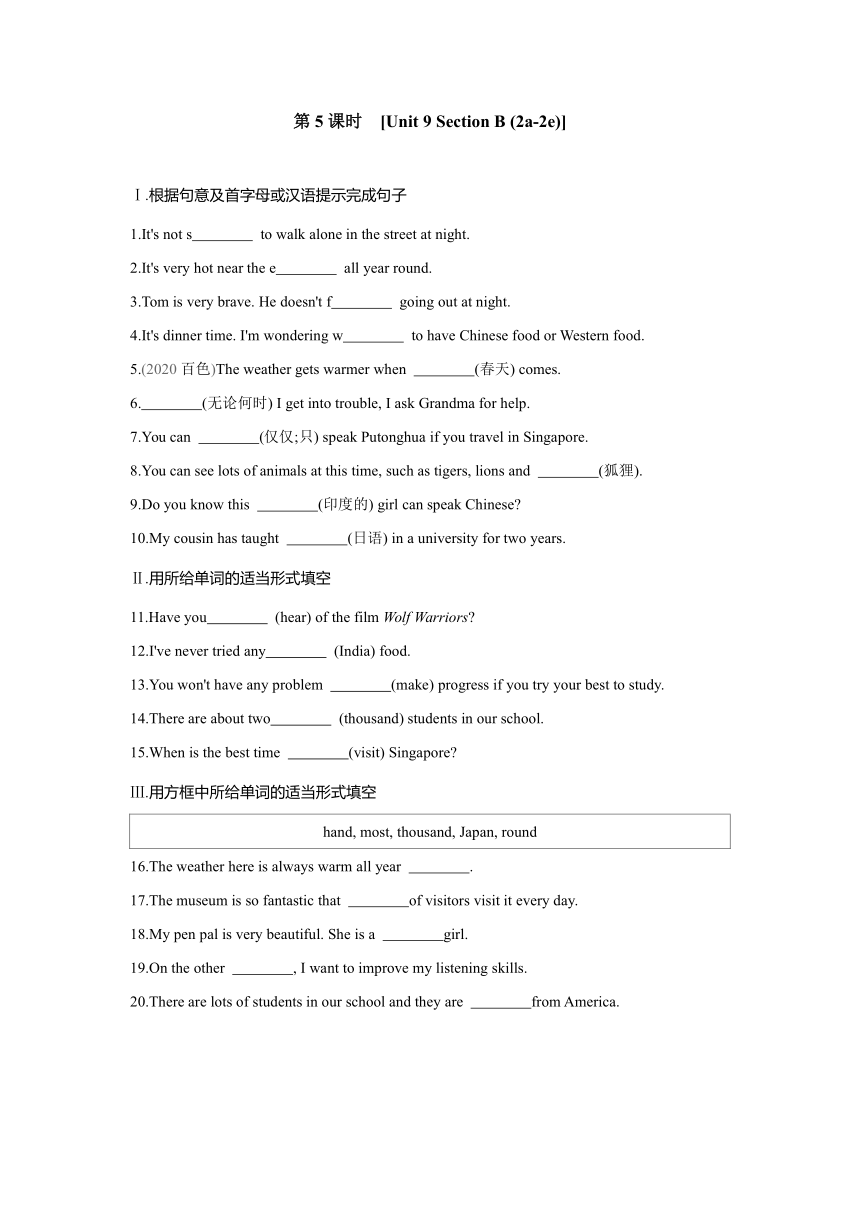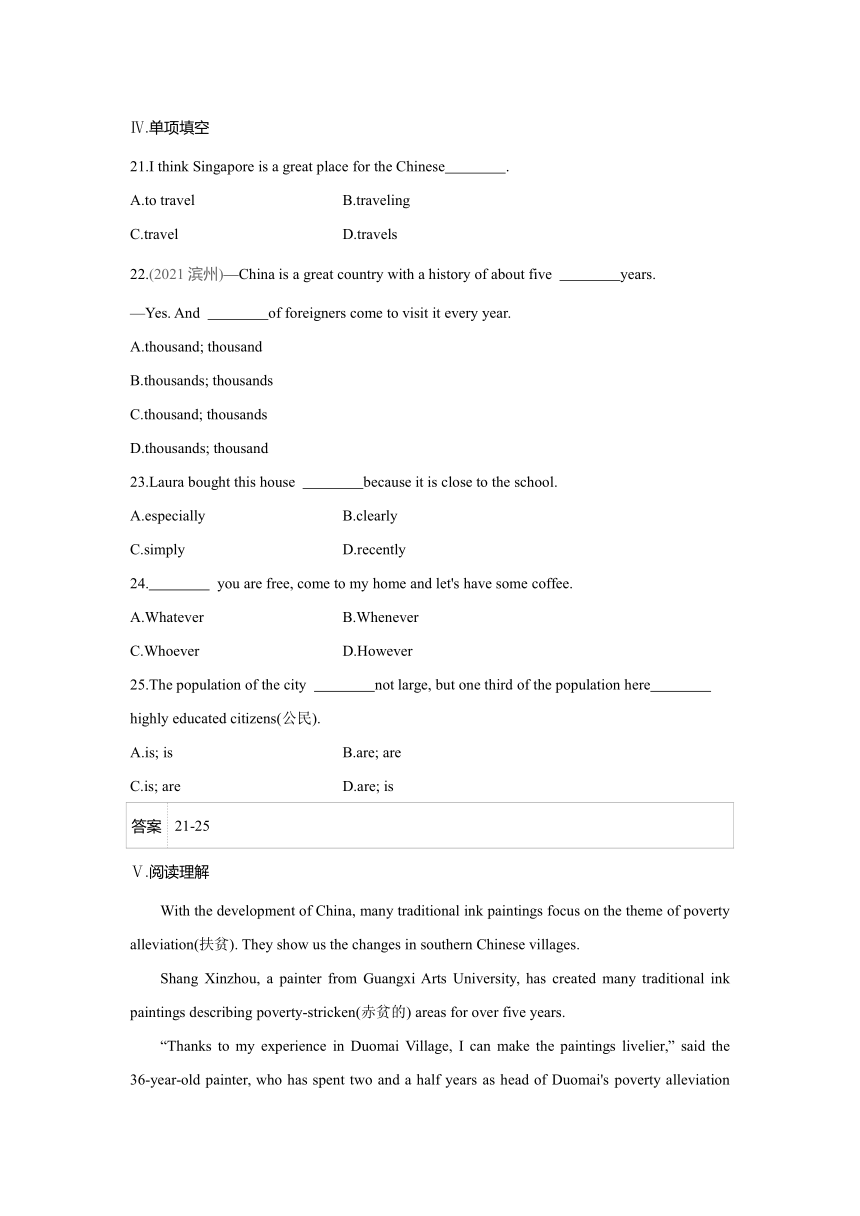Unit 9 Have you ever been to a museum? Section B (2a-2e)(word版,含答案)
文档属性
| 名称 | Unit 9 Have you ever been to a museum? Section B (2a-2e)(word版,含答案) |

|
|
| 格式 | docx | ||
| 文件大小 | 86.8KB | ||
| 资源类型 | 教案 | ||
| 版本资源 | 人教新目标(Go for it)版 | ||
| 科目 | 英语 | ||
| 更新时间 | 2022-04-08 15:50:58 | ||
图片预览


文档简介
第5课时 [Unit 9 Section B (2a-2e)]
Ⅰ.根据句意及首字母或汉语提示完成句子
1.It's not s to walk alone in the street at night.
2.It's very hot near the e all year round.
3.Tom is very brave. He doesn't f going out at night.
4.It's dinner time. I'm wondering w to have Chinese food or Western food.
5.(2020百色)The weather gets warmer when (春天) comes.
6. (无论何时) I get into trouble, I ask Grandma for help.
7.You can (仅仅;只) speak Putonghua if you travel in Singapore.
8.You can see lots of animals at this time, such as tigers, lions and (狐狸).
9.Do you know this (印度的) girl can speak Chinese
10.My cousin has taught (日语) in a university for two years.
Ⅱ.用所给单词的适当形式填空
11.Have you (hear) of the film Wolf Warriors
12.I've never tried any (India) food.
13.You won't have any problem (make) progress if you try your best to study.
14.There are about two (thousand) students in our school.
15.When is the best time (visit) Singapore
Ⅲ.用方框中所给单词的适当形式填空
hand, most, thousand, Japan, round
16.The weather here is always warm all year .
17.The museum is so fantastic that of visitors visit it every day.
18.My pen pal is very beautiful. She is a girl.
19.On the other , I want to improve my listening skills.
20.There are lots of students in our school and they are from America.
Ⅳ.单项填空
21.I think Singapore is a great place for the Chinese .
A.to travel B.traveling
C.travel D.travels
22.(2021滨州)—China is a great country with a history of about five years.
—Yes. And of foreigners come to visit it every year.
A.thousand; thousand
B.thousands; thousands
C.thousand; thousands
D.thousands; thousand
23.Laura bought this house because it is close to the school.
A.especially B.clearly
C.simply D.recently
24. you are free, come to my home and let's have some coffee.
A.Whatever B.Whenever
C.Whoever D.However
25.The population of the city not large, but one third of the population here
highly educated citizens(公民).
A.is; is B.are; are
C.is; are D.are; is
答案 21-25
Ⅴ.阅读理解
With the development of China, many traditional ink paintings focus on the theme of poverty alleviation(扶贫). They show us the changes in southern Chinese villages.
Shang Xinzhou, a painter from Guangxi Arts University, has created many traditional ink paintings describing poverty-stricken(赤贫的) areas for over five years.
“Thanks to my experience in Duomai Village, I can make the paintings livelier,” said the 36-year-old painter, who has spent two and a half years as head of Duomai's poverty alleviation team in Baise City, Guangxi Zhuang Autonomous Region.
Shang's paintings changed with the progress made in the fight against poverty. The focus of his works changed from poor local conditions and people's hard times to better environment and happy lives.In his paintings, stone roads and old houses were replaced by wide roads and new buildings.
“I like drawing people's real lives, and paintings became a bridge for communication between me and the local people,” said Shang.
During his stay, he often put his paintings about the local life in social media to help villagers sell their products. To enrich the local nightlife, he sold paintings to buy street lamps so people could enjoy square dancing in the evenings.
Shang's excellent works were popular in the village. “I love his paintings and they show the earth-shaking changes in our village,” said a farmer.
“I've seen the local poverty alleviation with my own eyes. I want to record the changes with my brush and create more works about people. I want to tell stories of the country's battle against poverty,” said Shang.
26.What made Shang's paintings livelier
A.His happy life.
B.His stay in a city.
C.His experience in a village.
D.His experience in a university.
27.Which may be Shang Xinzhou's last painting
28.What did Shang do for the people in Duomai Village
①He taught them to dance.
②He bought them street lamps.
③He helped them sell their products.
④He taught them to create paintings.
A.①④ B.②④
C.①③ D.②③
29.What does the underlined word “earth-shaking” in Paragraph 7 mean
A.difficult B.great
C.easy D.small
30.The passage mainly tells us a painter .
A.spent his whole life fighting against poverty in his city
B.tried to show the world traditional Chinese ink paintings
C.used his paintings to record the changes in southern Chinese villages
D.found the easiest way to make himself famous in his country
答案 26-30
答案
第5课时 [Unit 9 Section B (2a-2e)]
Ⅰ.1.safe 2.equator 3.fear 4.whether
5.spring 6.Whenever 7.simply/only
8.foxes 9.Indian 10.Japanese
Ⅱ.11.heard 12.Indian 13.making
14.thousand 15.to visit
Ⅲ.16.round 17.thousands 18.Japanese
19.hand 20.mostly
Ⅳ.21.A
22.C thousand 前面有基数词时,表示具体数量,不用复数形式;“thousands of+名词复数”意为“成千上万的……”。C。
23.C 副词辨析。句意:劳拉之所以买这所房子仅仅是因为它离学校近。especially意为“尤其”;clearly意为“清楚地”;simply意为“仅仅”;recently意为“近来”。结合句意可知选C。
24.B
25.C population表示“人口”总称,作主语时,谓语动词常用单数形式;表示“几分之几”的“人口”则是指具体的人口,作主语时,谓语动词用复数形式。
Ⅴ.[主旨大意] 随着中国的发展,许多以扶贫为主题的传统水墨画展示了中国南方乡村的变化。广西艺术学院的画家尚新周通过传统水墨画描绘了贫困地区的变化。
26.C 细节理解题。由第三段第一句中的“Thanks to my experience in Duomai Village, I can make the paintings livelier”可知,尚新周在多脉村的经历使他的画更生动。
27.A 推理判断题。由第四段最后一句“In his paintings, stone roads and old houses were replaced by wide roads and new buildings.”可知,在他的画中,宽阔的道路和崭新的建筑取代了石子路和破旧的房子。由此判断A符合他现在的水墨画特点。
28.D 细节理解题。由倒数第三段中的“to help villagers sell their products”可知,他帮助村民卖产品;由“he sold paintings to buy street lamps”可知,他为村民买了路灯。D。
29.B 词义猜测题。根据全文内容及后面的“changes”可判断是很大的变化,B。
30.C 主旨大意题。本文主要讲述水墨画家尚新周用画来记录中国南方乡村的变化。C。
Ⅰ.根据句意及首字母或汉语提示完成句子
1.It's not s to walk alone in the street at night.
2.It's very hot near the e all year round.
3.Tom is very brave. He doesn't f going out at night.
4.It's dinner time. I'm wondering w to have Chinese food or Western food.
5.(2020百色)The weather gets warmer when (春天) comes.
6. (无论何时) I get into trouble, I ask Grandma for help.
7.You can (仅仅;只) speak Putonghua if you travel in Singapore.
8.You can see lots of animals at this time, such as tigers, lions and (狐狸).
9.Do you know this (印度的) girl can speak Chinese
10.My cousin has taught (日语) in a university for two years.
Ⅱ.用所给单词的适当形式填空
11.Have you (hear) of the film Wolf Warriors
12.I've never tried any (India) food.
13.You won't have any problem (make) progress if you try your best to study.
14.There are about two (thousand) students in our school.
15.When is the best time (visit) Singapore
Ⅲ.用方框中所给单词的适当形式填空
hand, most, thousand, Japan, round
16.The weather here is always warm all year .
17.The museum is so fantastic that of visitors visit it every day.
18.My pen pal is very beautiful. She is a girl.
19.On the other , I want to improve my listening skills.
20.There are lots of students in our school and they are from America.
Ⅳ.单项填空
21.I think Singapore is a great place for the Chinese .
A.to travel B.traveling
C.travel D.travels
22.(2021滨州)—China is a great country with a history of about five years.
—Yes. And of foreigners come to visit it every year.
A.thousand; thousand
B.thousands; thousands
C.thousand; thousands
D.thousands; thousand
23.Laura bought this house because it is close to the school.
A.especially B.clearly
C.simply D.recently
24. you are free, come to my home and let's have some coffee.
A.Whatever B.Whenever
C.Whoever D.However
25.The population of the city not large, but one third of the population here
highly educated citizens(公民).
A.is; is B.are; are
C.is; are D.are; is
答案 21-25
Ⅴ.阅读理解
With the development of China, many traditional ink paintings focus on the theme of poverty alleviation(扶贫). They show us the changes in southern Chinese villages.
Shang Xinzhou, a painter from Guangxi Arts University, has created many traditional ink paintings describing poverty-stricken(赤贫的) areas for over five years.
“Thanks to my experience in Duomai Village, I can make the paintings livelier,” said the 36-year-old painter, who has spent two and a half years as head of Duomai's poverty alleviation team in Baise City, Guangxi Zhuang Autonomous Region.
Shang's paintings changed with the progress made in the fight against poverty. The focus of his works changed from poor local conditions and people's hard times to better environment and happy lives.In his paintings, stone roads and old houses were replaced by wide roads and new buildings.
“I like drawing people's real lives, and paintings became a bridge for communication between me and the local people,” said Shang.
During his stay, he often put his paintings about the local life in social media to help villagers sell their products. To enrich the local nightlife, he sold paintings to buy street lamps so people could enjoy square dancing in the evenings.
Shang's excellent works were popular in the village. “I love his paintings and they show the earth-shaking changes in our village,” said a farmer.
“I've seen the local poverty alleviation with my own eyes. I want to record the changes with my brush and create more works about people. I want to tell stories of the country's battle against poverty,” said Shang.
26.What made Shang's paintings livelier
A.His happy life.
B.His stay in a city.
C.His experience in a village.
D.His experience in a university.
27.Which may be Shang Xinzhou's last painting
28.What did Shang do for the people in Duomai Village
①He taught them to dance.
②He bought them street lamps.
③He helped them sell their products.
④He taught them to create paintings.
A.①④ B.②④
C.①③ D.②③
29.What does the underlined word “earth-shaking” in Paragraph 7 mean
A.difficult B.great
C.easy D.small
30.The passage mainly tells us a painter .
A.spent his whole life fighting against poverty in his city
B.tried to show the world traditional Chinese ink paintings
C.used his paintings to record the changes in southern Chinese villages
D.found the easiest way to make himself famous in his country
答案 26-30
答案
第5课时 [Unit 9 Section B (2a-2e)]
Ⅰ.1.safe 2.equator 3.fear 4.whether
5.spring 6.Whenever 7.simply/only
8.foxes 9.Indian 10.Japanese
Ⅱ.11.heard 12.Indian 13.making
14.thousand 15.to visit
Ⅲ.16.round 17.thousands 18.Japanese
19.hand 20.mostly
Ⅳ.21.A
22.C thousand 前面有基数词时,表示具体数量,不用复数形式;“thousands of+名词复数”意为“成千上万的……”。C。
23.C 副词辨析。句意:劳拉之所以买这所房子仅仅是因为它离学校近。especially意为“尤其”;clearly意为“清楚地”;simply意为“仅仅”;recently意为“近来”。结合句意可知选C。
24.B
25.C population表示“人口”总称,作主语时,谓语动词常用单数形式;表示“几分之几”的“人口”则是指具体的人口,作主语时,谓语动词用复数形式。
Ⅴ.[主旨大意] 随着中国的发展,许多以扶贫为主题的传统水墨画展示了中国南方乡村的变化。广西艺术学院的画家尚新周通过传统水墨画描绘了贫困地区的变化。
26.C 细节理解题。由第三段第一句中的“Thanks to my experience in Duomai Village, I can make the paintings livelier”可知,尚新周在多脉村的经历使他的画更生动。
27.A 推理判断题。由第四段最后一句“In his paintings, stone roads and old houses were replaced by wide roads and new buildings.”可知,在他的画中,宽阔的道路和崭新的建筑取代了石子路和破旧的房子。由此判断A符合他现在的水墨画特点。
28.D 细节理解题。由倒数第三段中的“to help villagers sell their products”可知,他帮助村民卖产品;由“he sold paintings to buy street lamps”可知,他为村民买了路灯。D。
29.B 词义猜测题。根据全文内容及后面的“changes”可判断是很大的变化,B。
30.C 主旨大意题。本文主要讲述水墨画家尚新周用画来记录中国南方乡村的变化。C。
同课章节目录
- Unit 1 What's the matter?
- Section A
- Section B
- Unit 2 I'll help to clean up the city parks.
- Section A
- Section B
- Unit 3 Could you please clean your room?
- Section A
- Section B
- Unit 4 Why don't you talk to your parents?
- Section A
- Section B
- Unit 5 What were you doing when the rainstorm came
- Section A
- Section B
- Review of Units 1-5
- Unit 6 An old man tried to move the mountains.
- Section A
- Section B
- Unit 7 What's the highest mountain in the world?
- Section A
- Section B
- Unit 8 Have you read Treasure Island yet?
- Section A
- Section B
- Unit 9 Have you ever been to a museum?
- Section A
- Section B
- Unit 10 I've had this bike for three years.
- Section A
- Section B
